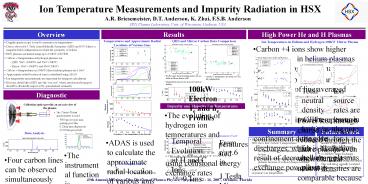Ion Temperature Measurements and Impurity Radiation in HSX - PowerPoint PPT Presentation
1 / 1
Title:
Ion Temperature Measurements and Impurity Radiation in HSX
Description:
Ion Temperature Measurements and Impurity Radiation in HSX ... found using measurements from Ha detectors and DEGAS simulations done by J. Lore ... – PowerPoint PPT presentation
Number of Views:26
Avg rating:3.0/5.0
Title: Ion Temperature Measurements and Impurity Radiation in HSX
1
Ion Temperature Measurements and Impurity
Radiation in HSX
A.R. Briesemeister, D.T. Anderson, K. Zhai,
F.S.B. Anderson HSX Plasma Laboratory, Univ. of
Wisconsin, Madison, USA
Results
High Power He and H Plasmas
Overview
QHS and Mirror Carbon Data Comparison
Temperatures and Approximate Radial Locations of
Various Ions
Ion Temperatures in Helium and Hydrogen 100kW
Mirror Plasma
- Doppler spectroscopy is used to measure ion
temperatures - Data is shown for 1 Tesla Quasi-Helically
Symmetry (QHS) and 10 Mirror a magnetic field
configuration in which the symmetry is broken - HSX plasmas are heated using up to 100kW of ECRH
- Carbon 4 temperatures in hydrogen plasmas are
- - QHS 50eV (100kW) and 35eV (50kW)
- - Mirror 60eV (100kW) and 45eV(50kW)
- Carbon 4 temperatures in 100kW Mirror helium
plasmas are 110eV - Approximate radial location of ions is calculated
using ADAS - Ion temperature measurements are important for
transport calculations - Hot ions should drive HSX into the ion root
where neoclassical transport should be
drastically improved by quasi-helical symmetry
- Carbon 4 ions show higher temperatures in helium
plasmas than in hydrogen plasma - Carbon temperatures are independent of line
averaged electron density in the observed range - Differences in C4 temperature suggests improved
ion confinement during He discharges, which is
likely a result of decreased charge exchange
power loss
Carbon Temperatures in He and H plasma
DEGAS Calculations for He and H
The following DEGAS calculations were performed
by J. Canik
1T Neutral Particle Density
1 T Ion Source Term
He
- For the same electron heating power ions are
hotter in Mirror than in QHS - Temperatures increase for increased electron
heating
- Carbon 2 temperatures are about 25eV for all
configurations
HH2
H
He
H2
100kW Electron Te and ne Profiles
Total neutral density will be lower in the core
for helium plasmas
Ion source rates are lower in the core for helium
plasmas
Electron Temperatures 100kW Mirror
Diagnostic
Profiles are the same at the edge
0.5 T Ion Source Term
0.5T Neutral Particle Density
0.5 T Charge Exchange Power Loss
HH2
Collection optics provide an on-axis view of the
plasma
Impurity and Majority Ion Temperatures
H2
H
He
He
Electron Density 100kW Mirror
H
He
- The evolution of hydrogen ion temperatures and
impurity ion temperatures have been calculated
using collisional energy exchange rates - Charge exchange is the dominant energy loss term
for hydrogen ions - Ion confinement time was adjusted to help match
calculated and measured temperatures - Calculations show good agreement between impurity
and majority ion temperatures at all times
- 1m Czerny-Turner spectrometer is used
- 3600 groove per mm grating provides 0.25nm/mm
dispersion (0.065nm per pixel)
Power lost through charge exchange is reduced
through the entire plasma even when the total
neutral densities are comparable because the
charge exchange cross section is much smaller for
helium than for hydrogen
Future Work
Summary
Data Analysis
Parameters Used
Temporal Evolution of H and C Ions
- Measurements made using passive spectroscopy in
HSX show that Carbon4 temperatures - increase with increased electron heating
- are higher in shots with the helical symmetry
broken - are higher in helium plasmas than hydrogen
plasmas because of reduced charge exchange power
loss - Impurity ion temperatures can be used as an
indicator of primary ion temperatures
- ADAS is used to calculate the approximate radial
location of various ions based on measured
profiles - -Electron temperature and density profiles are
measured with Thomson Scattering - -Neutral hydrogen profiles are found using
measurements from Ha detectors and DEGAS
simulations done by J. Lore
- Further study of ion transport is needed to fully
explain the mechanism for the observed
temperature differences - A ChERS(Charge Exchange Recombination
Spectroscopy) system is currently being
developed. This will allow spatially localized
temperature measurements of the entire plasma.
From r/a.6 in 1 Tesla Mirror 100kW ECRH
heating Te300eV ne3.21012 cm-3 nc1010 cm-3 nH
neutral1010 cm-3 timp2 ms
- The instrumental function is measured using a
mercury calibration lamp - Data is fit with a Gaussian function
- The difference between the instrumental function
and the fitted Gaussian gives the Doppler
broadening and temperature
- Four carbon lines can be observed simultaneously
- The three lines on the left are all emitted by
C4 ions and typically produce the same measured
temperature - The line on the far right is produce by C2 and
consistently shows a lower temperature than the
other lines
horizontal error bars indicate integration time
Wavelengths Used
- Boron 3 ?282.168nm
- Carbon 4 ?227.091, 227.725 and 227.792nm
- Carbon 2 ?229.687nm
- Oxygen 4 ?278.101nm
tei/e9.1ms tei/p0.039ms tep/e12ms tep/i14ms
tcxp/n7.8ms































